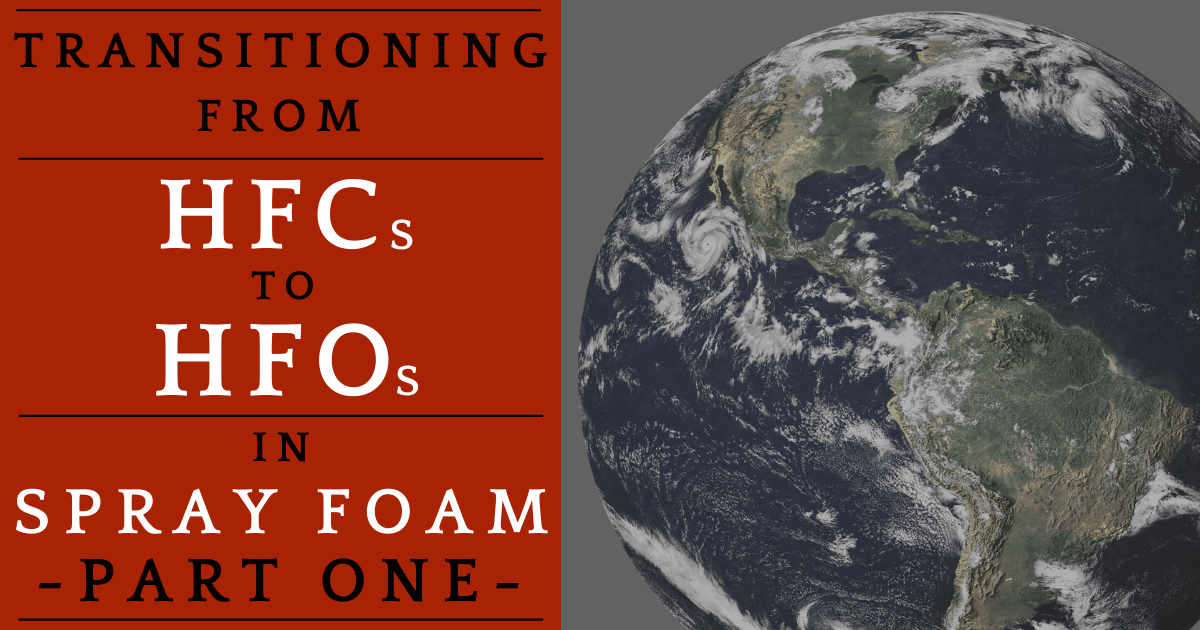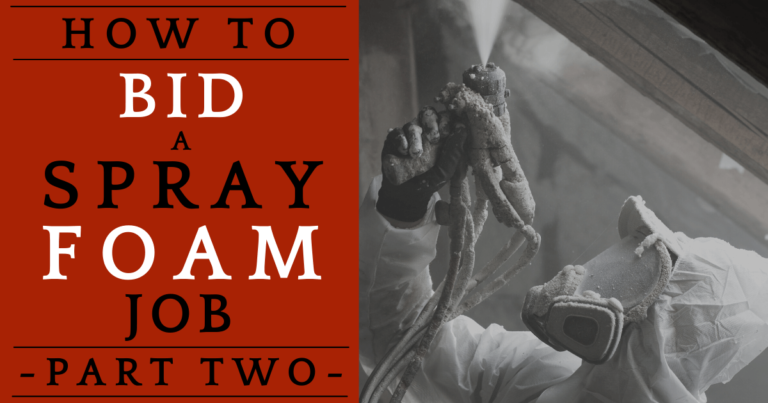Understanding the Transition from HFC to HFO in Spray Foam Blowing Agents, Part One: Spray Foam Chemistry
Spray foam insulation is a revolutionary product with virtually endless applications, including insulating our homes, businesses, and barns.
Each spray foam component plays a role in creating the end product we know and love.
But change is inevitable, isn’t it?
And sometimes, new rules and regulations are put into practice.
The EPA (or Environmental Protection Agency) of the United States recently changed its guidelines regarding hydrofluorocarbon – or HFC – use in a variety of products, including blowing agents in spray foam insulation.
These new guidelines have led many states to enact laws transitioning from HFC to HFO (hydrofluoroolefin) use in spray foam.
(Stay tuned – we will discuss why in our next post!)
To better understand HFCs, HFOs, and blowing agents, we first need to examine spray foam chemistry.
Let’s jump in!
Spray Foam Chemistry
To understand the HFC to HFO transition, let’s dive into the chemistry of spray foam insulation.
Now, don’t panic!
We think chemistry is cool – it’s responsible for many of life’s great mysteries, after all – but we know that chemistry is not fun for everyone, so there’s no need to fret…
We won’t go too chemically in-depth in this post.
However, for those who want to learn more about the chemical reactions that form polyurethane foam, we will include some helpful resource links for your perusal.
Everybody good? Great! Back to it.
Spray foam insulation is made up of polyurethane foam, and polyurethane foam is found in countless products in today’s world – anything from seat cushions to toys.
Unlike other polyurethane products, however, spray foam insulation is chemically crafted and cured on-site.
Since polyurethane is created through chemical reaction, the components of spray foam insulation need to be kept separate from one another, so that foam won’t form before it is needed!
Therefore, the building blocks of spray foam are stored in two different chemical concoctions – “A side” and “B side.”
When the two sides are mixed, POOF! You end up with spray foam insulation!
What chemicals create this foaming reaction? Let’s take a look at the chemical components of spray foam to find out!
What Makes Up the A Side of Spray Foam Insulation?
The A side of spray foam primarily comprises a type of isocyanate, such as methylene diphenyl diisocyanate, or “MDI.”
Now, stick with us here!
Yes, that’s a big, crazy-sounding chemical name, but a chemical’s name is simply a description of its structure and composition…
…like symbols you find on a map!
Without the map key, the symbols may seem like mumbo-jumbo, but if you look more closely at each one – using the map key – you can unlock the secrets contained in that (ancient treasure?!) map of yours!
The same holds true for chemical names.
Take MDI – methylene diphenyl diisocyanate – for instance.
The term “methylene” refers to a specific group of atoms arranged in a certain way – in this case, a single carbon atom bonded with two hydrogen atoms – which act together as a “functional group.”
A “functional group” is a particular group of atoms – often with a specific shape or bonding pattern – that work together as a team, and act certain ways when connected with molecules. If you change the parts or shape of a functional group, the role it plays will likely change, too.
For instance, methylene groups are related to methyl groups – and both derive from methane, a greenhouse gas you’ve probably heard of.
However, since methyl and methylene groups are slightly different – methyl groups are made of one carbon atom and three hydrogen atoms, instead of the two found in methylene groups – they behave differently in chemical reactions.
But let’s get back to spray foam.
“Isocyanate” – the main ingredient of MDI – is another functional group, which is made up of nitrogen (N), carbon (C), and oxygen (O) atoms bonded in a structure that looks something like this:
R—N=C=O
(“R” in this example – and many organic chemistry examples – just stands for whatever molecule the functional group has bonded to.)
Chemists have experimented with different isocyanate compounds to find stable options, but stable isocyanate compounds – like MDI – can vary among foam blends. For more information about which type of isocyanate is contained in your spray foam, refer to its MSDS sheet, or reach out to your foam manufacturer.
Why think about chemicals (or their names) at all if you aren’t a chemist?
Well, even if you don’t care what that one hydrogen atom can make a difference to a chemical reaction, we believe it’s important to understand that intimidating things aren’t as overwhelming if you can break them down to their building blocks!
After all, everything in the universe is made of atoms arranged in certain patterns. (Wowza, right!?)
And spray foam is no different!
The main takeaway here is this:
Isocyanate is the key ingredient in spray foam’s A side, but foam won’t form without mixing A side with B side.
So let’s examine B side now, to see how blowing agents – which include HFCs and HFOs – play a role in the formation spray foam insulation.
What is contained in the B Side of Spray Foam Insulation?
The B Side of spray foam is a hodgepodge of foam ingredients including polyols, blowing agents, catalysts, and fire retardants.
Foam manufacturers may also add additional components, or work with different ratios of the above ingredients in B side, to create special foam blends (like cold blends, etc.).
Each ingredient a spray foam manufacturer adds plays a role in the reaction or end product of spray foam.
The basic foam-making ingredients are the isocyanate in A side and the (polyether or polyester) polyol (described here) in B side. When those two ingredients are mixed, the end result is polyurethane foam.
So why is all the other stuff in the mix?
Well, catalysts help chemical reactions to happen faster or help create ideal environments for reactions to occur…
Fire retardants help prevent fire from starting in cured spray foam, with as little spreading and smoke production as possible…
And blowing agents help propel the spray foam onto the substrate (or receiving surface), assist with foam expansion, and (often) increase the foam’s insulating capabilities.
How does HFC and HFO fit into this picture? Great question!
HFCs and HFOs in Spray Foam
Hydrofluorocarbon (HFC) is part of most blowing agents manufactured today.
However, due to updated EPA guidelines, many states are enacting laws that ban HFC use in spray foam blowing agents and require the use of hydrofluoroolefin – or HFO – instead.
Why?
We will discuss this answer in more depth in our next blog – but here’s the gist:
HFCs were created to replace chemicals that damaged the ozone layer of Earth’s atmosphere. As planned, HFCs don’t hurt the ozone layer – win! – but they have a high global warming potential.
So, scientists created hydrofluoroolefins – or HFOs!
Like HFCs, HFOs do not harm the ozone layer, but they also have a much smaller global warming potential.
That’s a win-win!
But change is hard, and it can’t happen overnight.
Blowing agents play a vital role in the behavior of spray foam insulation, and changing any ingredients in a well-oiled spray foam blend can drastically impact the end product.
Therefore, a period of overlap between HFC and HFO use is necessary, so foam manufacturers can create blends that work the same way as their HFC-based products.
Although many states have already passed legislation that requires HFO-based blowing agents in spray foam, world events have made HFO material difficult to obtain.
As a result, many spray foam companies have not yet transitioned to the use of HFO in their spray foam blends.
Any transition takes time, after all!
Growing pains during this transition are inevitable, but in the end, spray foam will still be stellar insulation, and it will help make our world a healthier place to live.
Conclusion
Spray foam insulation is a marvel of chemistry, and each of its chemical components plays a vital role in the end product.
After reading this post, we hope you better understand where HFCs and HFOs fit into the spray foam equation.
In Part Two of this blog post, we will discuss how HFCs and HFOs came to be, why the EPA guidelines require a transition from HFCs to HFOs, and which states are putting the EPA guidelines into practice.
If you have any questions about the HFC to HFO transition or need help sourcing spray foam that meets the requirements of your state give us a call!
Freedom Foam is always happy to help you on your spray foam journey.







